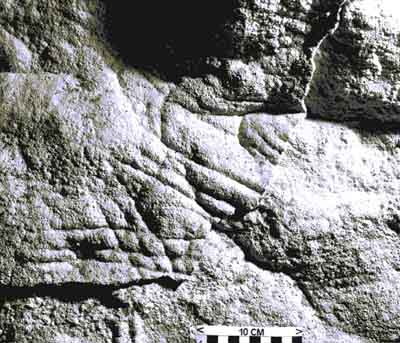Radiocarbon analysis of mineral accretions
 Figure 2. Exfoliating reprecipitated calcite skin containing within it sets of finger markings sandwiched between successive layers of formerly soft, but now hardened precipitate. The finger flutings can still be traced on the surface of the calcite skin, seen in situ on the left. Prung-kart Cave, South Australia.
|
The first technique to yield tangible direct dates for rock art was the determination of 14C in a secondary calcite skin reprecipitated over petroglyphs in Malangine Cave, South Australia (Bednarik 1981, 1984). Radiocarbon occurs in such deposits because about one half of its carbon derives from atmospheric carbon dioxide:
xCaCO3 + H2O + (x + y)CO2 ->/<- xCa(HCO3)2 + yCO2, (2)
where x and y are the molecular concentrations of free and locked carbonic acid, and are subject to the correlation y = K(T)x3, K(T) being a temperature-related constant (Wendt et al. 1967). Actually, the relationship is significantly more complex than is suggested by this reaction, but it will suffice in the present context. The condition of electroneutrality pertaining to it can be summarised as:
CH+ + 2CCa2+ – COH- – CHCO3- – 2CCO32- = 0, (3)
where CH+ is the concentration of hydrogen ions (moles/litre).
Limestone is dissolved by a combination of two processes which relate to the isotopic composition of the calcite precipitated in carbonate speleothems (Moore 1952): the open and the closed system. The carbon dioxide is usually derived from vegetation above the cave, which has either obtained it via photosynthesis and then released it after oxidation of dead plant matter, or has given rise to a community of mycorrhizal soil micro-organisms which then respire the gas.
The approximate age of reprecipitated calcite is therefore measurable by determination of its remnant content of radiocarbon, at least in theory. But there are, as with most dating methods, certain reservations. Carbonate speleothems may experience ‘radiocarbon rejuvenation’, for example where porosity is available for the deposition of younger carbonate, as well as through isotope exchange in the presence of moisture. An indication of the extent of such rejuvenation is given by the bulk carbon ratios from Malangine Cave, where an accretionary ceiling deposit over petroglyphs yielded 5550 +/- 55 carbon-years BP (Hv-10241), while an adjacent growth supplied a result of only 4425 +/- 75 BP (Hv-10240) (Bednarik 1984). But a thorium-uranium analysis of the first deposit provided an age of 28 000 +/- 2000 years BP (Bednarik 1997a), which gives an inkling of the massive distortion possible through the deposition of much younger solute in highly porous travertines.
Detailed research has shown that the most reliable dates of this type are from densely crystalline deposits, especially those of stalagmites (Bednarik 1981, 1998a), but we know of no instances in the world where stalagmites conceal rock art. Rock art occurs frequently on their surface, so they might provide a means of securing maximum ages for it. Stalactites sometimes do conceal rock art but their crystal structure is less dense, so they are less suitable. Recent research has also illustrated the great time span a travertine skin may take to form: the outer lamina of such a deposit in Prung-kart Cave, also in South Australia, has provided a result of 1150 +/- 80 BP (ANU-6963B), while the inner (and older) part of the same thin cutaneous deposit yielded 2660 +/- 70 BP (ANU-6963) (Bednarik 1998a). The complexities indicated are only some of those to be reckoned with, and they are also being illuminated by extraction and dating of organic matter from the laminae of complex sequences found in some cave sites (Figure 2, above).
Carbonates are not the only mineral accretions datable by radiocarbon. Oxalates, by virtue of being salts of oxalic acid derived from the atmosphere or organic sources, also contain 14C. Their frequent occurrence at some rock art sites has prompted their use in estimating the ages of rock paintings (Watchman 1990, 1991, 2000; Watchman and Campbell 1996; Campbell 2000; cf. Muzzolini 1999a), but the problem of rejuvenation, which also applies to them, needs to be addressed. Ideally, the radiocarbon isotope concentrations in the accretionary strata sandwiching the rock art refer to the time the organisms in question absorbed or assimilated atmospheric carbon, but there is an obvious time lag between that event and the precipitation of an accretion. Once deposited, these mineral layers are not closed carbon systems, they remain in most cases open to several potential processes of distortion: rejuvenation through deposition of younger solute, deposition of organic matter of various sources, and isotopic exchange or fractionation. Alan Watchman (pers. comm. Sept. 1994) has observed interstices in crystallised whewellite, one of the oxalates, which permit the precipitation of younger minerals subsequent to the initial deposition of the accretion. However, this potential is probably lower for oxalates than for carbonates, which may be more porous. Most certainly the spectacular series of ten carbon isotope results from a very thin section (2.11 mm) of heavily laminated oxalate crust in Walkunder Arch Cave, Queensland, covering 26 000 radiocarbon years, were perfectly in sequence, and demonstrate the great potential of this medium.
In summary, direct dating of rock art by radiocarbon analysis of contiguous mineral accretions is possible in some circumstances, but the rigorous interpretation of such results is exceedingly difficult. At the present stage of our knowledge it cannot be expected to provide reasonably reliable results unless used in the context of independent data derived from alternative dating approaches.
| Rock art dating – back to main page
References list for rock art dating |